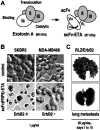Recombinant immunotoxins and retargeted killer cells: employing engineered antibody fragments for tumor-specific targeting of cytotoxic effectors
- PMID: 14704833
- PMCID: PMC11034274
- DOI: 10.1007/s00262-003-0482-8
Recombinant immunotoxins and retargeted killer cells: employing engineered antibody fragments for tumor-specific targeting of cytotoxic effectors
Abstract
Over the past years, monoclonal antibodies have attracted enormous interest as targeted therapeutics, and a number of such reagents are in clinical use. However, responses could not be achieved in all patients with tumors expressing high levels of the respective target antigens, suggesting that other factors such as limited recruitment of endogenous immune effector mechanisms can also influence treatment outcome. This justifies the search for alternative, potentially more effective reagents. Antibody-toxins and cytolytic effector cells genetically modified to carry antibody-based receptors on the surface, represent such tailor-made targeting vehicles with the potential of improved tumor localization and enhanced efficacy. In this way, advances in recombinant antibody technology have made it possible to circumvent problems inherent in chemical coupling of antibodies and toxins, and have allowed construction via gene fusion of recombinant molecules which combine antibody-mediated recognition of tumor cells with specific delivery of potent protein toxins of bacterial or plant origin. Likewise, recombinant antibody fragments provide the basis for the construction of chimeric antigen receptors that, upon expression in cytotoxic T lymphocytes (CTLs) or natural killer (NK) cells, link antibody-mediated recognition of tumor antigens with these effector cells' potent cytolytic activities, thereby making them promising cellular therapeutics for adoptive cancer therapy. Here, general principles for the derivation of cytotoxic proteins and effector cells with antibody-dependent tumor specificity are summarized, and current strategies to employ these molecules and cells for directed cancer therapy are discussed, focusing mainly on the tumor-associated antigens epidermal growth factor receptor (EGFR) and the closely related ErbB2 (HER2) as targets.
Figures



Similar articles
-
Re-targeting of cytotoxic T lymphocytes and/or natural killer cells to CEA-expressing tumor cells with anti-CEA antibody activity.Anticancer Res. 2005 Nov-Dec;25(6A):3725-32. Anticancer Res. 2005. PMID: 16302732 Review.
-
Targeting of tumor cells by lymphocytes engineered to express chimeric receptor genes.Cancer Immunol Immunother. 2004 Oct;53(10):893-903. doi: 10.1007/s00262-004-0523-y. Epub 2004 May 26. Cancer Immunol Immunother. 2004. PMID: 15168086 Free PMC article. Review.
-
Therapeutic antibodies.Curr Mol Med. 2004 Aug;4(5):539-47. doi: 10.2174/1566524043360483. Curr Mol Med. 2004. PMID: 15267225 Review.
-
Specific activation and targeting of cytotoxic lymphocytes through chimeric single chains consisting of antibody-binding domains and the gamma or zeta subunits of the immunoglobulin and T-cell receptors.Proc Natl Acad Sci U S A. 1993 Jan 15;90(2):720-4. doi: 10.1073/pnas.90.2.720. Proc Natl Acad Sci U S A. 1993. PMID: 8421711 Free PMC article.
-
Bispecific antibody-mediated redirection of NKG2D-CAR natural killer cells facilitates dual targeting and enhances antitumor activity.J Immunother Cancer. 2021 Oct;9(10):e002980. doi: 10.1136/jitc-2021-002980. J Immunother Cancer. 2021. PMID: 34599028 Free PMC article.
Cited by
-
Expression of IL-15 in NK cells results in rapid enrichment and selective cytotoxicity of gene-modified effectors that carry a tumor-specific antigen receptor.Cancer Immunol Immunother. 2012 Sep;61(9):1451-61. doi: 10.1007/s00262-012-1212-x. Epub 2012 Feb 5. Cancer Immunol Immunother. 2012. PMID: 22310931 Free PMC article.
-
Cellular and complement-dependent cytotoxicity of Ep-CAM-specific monoclonal antibody MT201 against breast cancer cell lines.Br J Cancer. 2005 Jan 31;92(2):342-9. doi: 10.1038/sj.bjc.6602310. Br J Cancer. 2005. PMID: 15655555 Free PMC article.
-
Fusion of apoptosis-related protein Cytochrome c with anti-HER-2 single-chain antibody targets the suppression of HER-2+ breast cancer.J Cell Mol Med. 2021 Nov;25(22):10638-10649. doi: 10.1111/jcmm.17001. Epub 2021 Oct 25. J Cell Mol Med. 2021. PMID: 34697906 Free PMC article.
-
In vitro effects and ex vivo binding of an EGFR-specific immunotoxin on rhabdomyosarcoma cells.J Cancer Res Clin Oncol. 2015 Jun;141(6):1049-61. doi: 10.1007/s00432-014-1884-z. Epub 2014 Nov 30. J Cancer Res Clin Oncol. 2015. PMID: 25433506 Free PMC article.
-
The library of human miniantibodies in the phage display format: designing and testing.Dokl Biochem Biophys. 2005 Nov-Dec;405:437-40. doi: 10.1007/s10628-005-0134-3. Dokl Biochem Biophys. 2005. PMID: 16480147 No abstract available.
References
-
- Altenschmidt Clin Cancer Res. 1996;2:1001. - PubMed
-
- Altenschmidt J Immunol. 1997;159:5509. - PubMed
-
- Alvarez-Vallina Eur J Immunol. 1996;26:2304. - PubMed
-
- Azemar M, Djahansouzi S, Jäger E, Solbach C, Schmidt M, Maurer AB, Mross K, Unger C, Minckwitz G, Dall P, Groner B, Wels W. Regression of cutaneous tumor lesions in patients intratumorally injected with a recombinant single-chain antibody-toxin targeted to ErbB2/HER2. Breast Cancer Research and Treatment. 2003;82:155–164. - PubMed
Publication types
MeSH terms
Substances
LinkOut - more resources
Full Text Sources
Other Literature Sources
Research Materials
Miscellaneous

